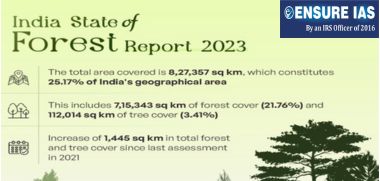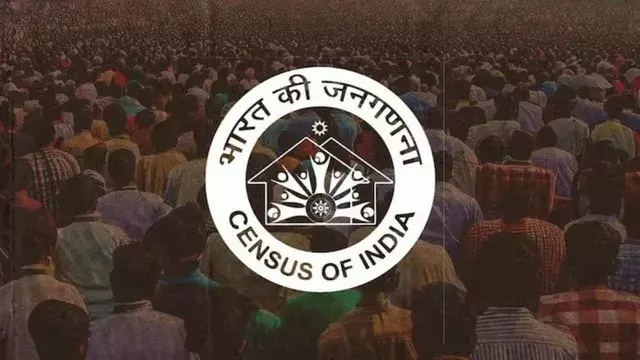- Courses
- GS Full Course 1 Year
- GS Full Course 2 Year
- GS Full Course 3 Year
- GS Full Course Till Selection
- Answer Alpha: Mains 2025 Mentorship
- MEP (Mains Enrichment Programme) Data, Facts
- Essay Target – 150+ Marks
- Online Program
- GS Recorded Course
- Polity
- Geography
- Economy
- Ancient, Medieval and Art & Culture AMAC
- Modern India, Post Independence & World History
- Environment
- Governance
- Science & Technology
- International Relations and Internal Security
- Disaster Management
- Ethics
- NCERT Current Affairs
- Indian Society and Social Issue
- NCERT- Science and Technology
- NCERT - Geography
- NCERT - Ancient History
- NCERT- World History
- NCERT Modern History
- CSAT
- 5 LAYERED ARJUNA Mentorship
- Public Administration Optional
- ABOUT US
- OUR TOPPERS
- TEST SERIES
- FREE STUDY MATERIAL
- VIDEOS
- CONTACT US
18th India State of Forest Report (ISFR) 2023
18th India State of Forest Report (ISFR) 2023

- Shri Bhupender Yadav, the Union Minister for Environment, Forest and Climate Change, released the India State of Forest Report 2023 (ISFR 2023) on December 21, 2024, at the Forest Research Institute (FRI) in Dehradun.
- The ISFR is a biennial publication brought out by the Forest Survey of India (FSI), offering an in-depth assessment of the forest and tree resources of the country.
- The ISFR 2023 marks the 18th edition of the report and presents crucial data on various aspects of India’s forests, including forest cover, tree cover, mangrove cover, carbon stock, growing stock, and more.
- The report is based on remote sensing satellite data and the National Forest Inventory (NFI), which involves extensive field-based assessment.
Key Highlights of the India State of Forest Report 2023
Total Forest and Tree Cover in India:
- Total Forest and Tree Cover: 827,357 sq km, which constitutes 25.17% of India’s geographical area.
- Forest Cover: 715,343 sq km (21.76% of the geographical area)
- Tree Cover: 112,014 sq km (3.41% of the geographical area)
-
Increase in Forest and Tree Cover (since 2021):
- Total increase: 1,445 sq km
- Forest Cover Increase: 156 sq km
- Tree Cover Increase: 1,289 sq km
- Total increase: 1,445 sq km
States with Maximum Increase in Forest and Tree Cover:
|
State |
Increase in Forest & Tree Cover (sq km) |
|
Chhattisgarh |
684 |
|
Uttar Pradesh |
559 |
|
Odisha |
559 |
|
Rajasthan |
394 |
States with Maximum Increase in Forest Cover:
- Mizoram: 242 sq km
- Gujarat: 180 sq km
- Odisha: 152 sq km
Top States by Forest and Tree Cover Area:
|
State |
Forest and Tree Cover Area (sq km) |
|
Madhya Pradesh |
85,724 |
|
Arunachal Pradesh |
67,083 |
|
Maharashtra |
65,383 |
Top States by Forest Cover Area:
|
State |
Forest Cover Area (sq km) |
|
Madhya Pradesh |
77,073 |
|
Arunachal Pradesh |
65,882 |
|
Chhattisgarh |
55,812 |
States with Highest Forest Cover as Percentage of Geographical Area:
|
State/UT |
Forest Cover (%) of Geographical Area |
|
Lakshadweep |
91.33% |
|
Mizoram |
85.34% |
|
Andaman & Nicobar Islands |
81.62% |
States with Over 33% of Geographical Area Under Forest Cover:
- 19 States/UTs have more than 33% of their geographical area under forest cover.
- 8 States/UTs have forest cover above 75%:
- Mizoram, Lakshadweep, Andaman & Nicobar Islands, Arunachal Pradesh, Nagaland, Meghalaya, Tripura, and Manipur.
Other Key Findings:
Mangrove Cover:
- Total Mangrove Cover in India: 4,992 sq km. Mangroves are essential for coastal protection and biodiversity, as well as carbon sequestration.
Growing Stock (Wood Volume) of Forests:
- Total Growing Stock (wood volume) of India’s forests and trees outside forests: 6,430 million cubic meters (cum).
- Inside Forests: 4,479 million cum
- Outside Forests: 1,951 million cum
-
Increase in Growing Stock since 2021:
- Total increase: 262 million cum
- 91 million cum increase inside forests
- 171 million cum increase outside forests
- Total increase: 262 million cum
Bamboo Area:
-
Bamboo-bearing area in India: 154,670 sq km
- Increase: 5,227 sq km since the last assessment (2021).
Timber Production Potential:
- Annual Potential Timber Production from trees outside forests: 91.51 million cubic meters.
Carbon Stock:
- Total Carbon Stock in India’s forests: 7,285.5 million tonnes.
- Increase in Carbon Stock: 81.5 million tonnes since the previous assessment.
- Carbon Sequestration: India’s total carbon stock is now equivalent to 30.43 billion tonnes of CO2.
- This indicates that, compared to the base year of 2005, India has already achieved 2.29 billion tonnes of additional carbon sink, nearing the target of 2.5 to 3.0 billion tonnes by 2030.
Conclusion:
The India State of Forest Report 2023 (ISFR 2023) paints an optimistic picture of the state of India’s forests, showcasing steady progress in forest and tree cover, growing stock, and carbon sequestration. The findings reflect the country’s ongoing efforts towards achieving environmental sustainability, particularly in carbon sequestration and climate change mitigation. Additionally, the increase in bamboo area and mangrove cover marks positive strides in biodiversity conservation.
The report highlights the success of various forest conservation initiatives, including agroforestry and mangrove restoration, which will continue to contribute to India’s ecological resilience and support its climate action goals.
| Also Read | |
| UPSC Prelims Result | UPSC Daily Current Affairs |
| UPSC Monthly Mgazine | Previous Year Interview Questions |
| Free MCQs for UPSC Prelims | UPSC Test Series |
| ENSURE IAS NOTES | Our Booklist |




